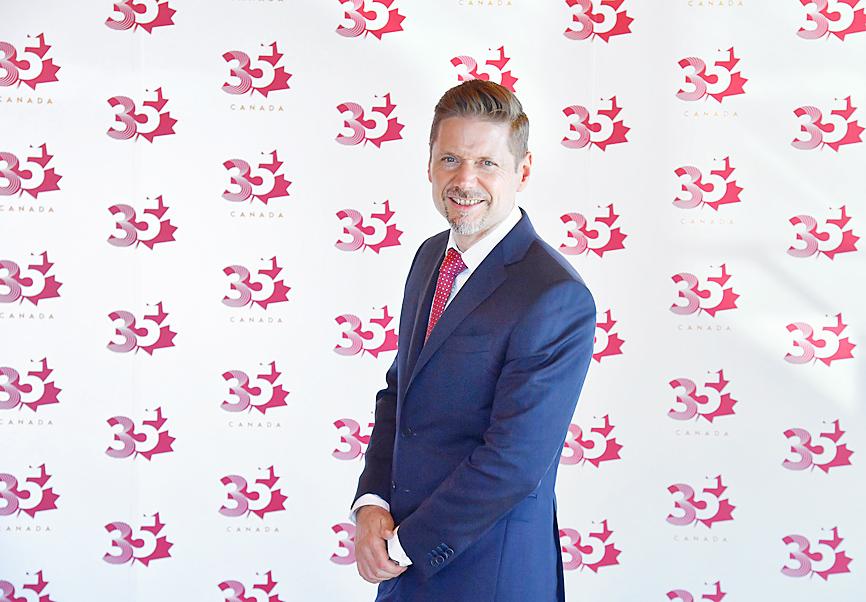Canada’s de facto embassy is celebrating its 35th anniversary in Taiwan this year, having witnessed the nation’s democratic transformation amid growing cooperation between Taipei and Ottawa in multiple areas, Canadian Trade Office in Taipei (CTOT) Executive Director Jordan Reeves said.
CTOT represents Canada’s interests in Taiwan in the absence of official diplomatic ties.
“We’re celebrating CTOT’s 35th year, but we’re also celebrating Taiwan’s successful transition to a high-tech democratic society, because this has certainly contributed to the richness and diversity of our people-to-people ties today,” Reeves said.

Photo: CNA
CTOT opened on Nov. 28, 1986, with only three employees and a goal of supporting bilateral exchanges and Canadians living in Taiwan, he said.
“At the time, there were no direct flights to Canada, bilateral trade was only C$1.6 billion [US$1.25 billion] and of course, Taiwan at that time was still under martial law,” he said.
Since then, Taiwan has changed a great deal. It has become a democracy, with its first direct presidential election held in 1996, he said.
“Taiwan has also made enormous strides in terms of gender equality, human rights, democratic governance, media freedom, all these areas, and has become a very trusted friend and trading partner for Canada,” Reeves said.
Trade between the two countries was valued at C$7.5 billion in the first nine months of the year, he said, adding that trade has increased 10 percent annually since the office opened.
Today, three airlines offer direct flights between Taiwan and Canada, although most have been suspended due to the COVID-19 pandemic.
Reeves said that since 1986, the two countries have signed 40 memorandums of understanding in areas ranging from agricultural science to transportation and safety, with 28 still in place.
“You can say that the expansion of our office, our size and responsibilities have also very closely tracked Taiwan’s transition to a vibrant and economically diverse, inclusive society,” he said.
Naming one area of close bilateral cooperation, Reeves said Taiwan’s national health insurance scheme, launched in 1995, was partly modeled on Canada’s universal healthcare system.
More recently, Canadian public health officials have participated in discussions with Taiwan’s Ministry of Health and Welfare to learn from Taiwan how to best control and manage COVID-19, he said.
Another area of cooperation is on indigenous issues, and the two countries have for two decades organized exchanges and collaboration between indigenous leaders, policymakers and artists, Reeves said.
“We also started, back in 2010, a working holiday program for Taiwanese youth, and under that program to date, 12,000 Taiwanese youth have visited Canada,” he said.
Looking to the future, Reeves said that the latest round of the annual Canada-Taiwan economic dialogues, held on Dec. 14, would bolster supply chain cooperation, and deepen bilateral trade and investment ties, with plans to undertake a joint supply chain study in sectors of mutual interest.
The two countries also discussed organizing a series of business roundtables beginning next year focused on electric vehicles, 5G, advanced manufacturing and other areas, a CTOT news release said.
Taiwan was Canada’s 15th-largest trading partner and its sixth-largest in Asia last year, CTOT said.

Beijing could eventually see a full amphibious invasion of Taiwan as the only "prudent" way to bring about unification, the US Department of Defense said in a newly released annual report to Congress. The Pentagon's "Annual Report to Congress: Military and Security Developments Involving the People's Republic of China 2025," was in many ways similar to last year’s report but reorganized the analysis of the options China has to take over Taiwan. Generally, according to the report, Chinese leaders view the People's Liberation Army's (PLA) capabilities for a Taiwan campaign as improving, but they remain uncertain about its readiness to successfully seize

Taiwan is getting a day off on Christmas for the first time in 25 years. The change comes after opposition parties passed a law earlier this year to add or restore five public holidays, including Constitution Day, which falls on today, Dec. 25. The day marks the 1947 adoption of the constitution of the Republic of China, as the government in Taipei is formally known. Back then the Chinese Nationalist Party (KMT) governed China from Nanjing. When the KMT, now an opposition party in Taiwan, passed the legislation on holidays, it said that they would help “commemorate the history of national development.” That

Trips for more than 100,000 international and domestic air travelers could be disrupted as China launches a military exercise around Taiwan today, Taiwan’s Civil Aviation Administration (CAA) said yesterday. The exercise could affect nearly 900 flights scheduled to enter the Taipei Flight Information Region (FIR) during the exercise window, it added. A notice issued by the Chinese Civil Aviation Administration showed there would be seven temporary zones around the Taiwan Strait which would be used for live-fire exercises, lasting from 8am to 6pm today. All aircraft are prohibited from entering during exercise, it says. Taipei FIR has 14 international air routes and

Snow fell on Yushan (Jade Mountain, 玉山) yesterday morning as a continental cold air mass sent temperatures below freezing on Taiwan’s tallest peak, the Central Weather Administration (CWA) said. Snowflakes were seen on Yushan’s north peak from 6:28am to 6:38am, but they did not fully cover the ground and no accumulation was recorded, the CWA said. As of 7:42am, the lowest temperature recorded across Taiwan was minus-5.5°C at Yushan’s Fengkou observatory and minus-4.7°C at the Yushan observatory, CWA data showed. On Hehuanshan (合歡山) in Nantou County, a low of 1.3°C was recorded at 6:39pm, when ice pellets fell at Songsyue Lodge (松雪樓), a